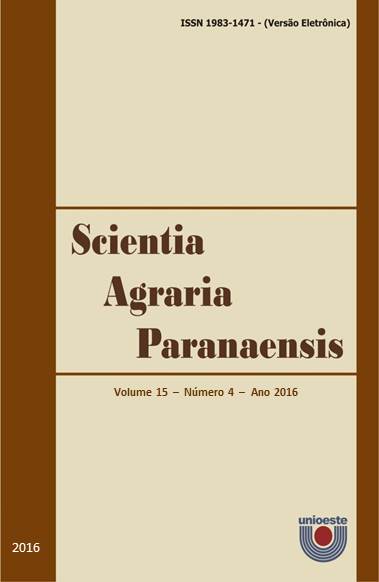Levantamento dos principais fungicidas e inseticidas comercializados pelas agropecuárias de Bento Gonçalves para utilização na cultura da videira
DOI:
https://doi.org/10.18188/sap.v15i4.12121Palavras-chave:
agrotóxicos, uva, Vitis spp.Resumo
A videira é uma cultura em expansão no Brasil, e o Rio Grande do Sul compreende a maior área plantada com a cultura. A videira está sujeita ao ataque de inúmeros patógenos e pragas, e os tratamentos fitossanitários podem atingir 30% do custo de produção. Vários estudos são realizados com a finalidade de encontrar alternativas de controle, mas, o principal método utilizado ainda é o controle químico. Diante do exposto, objetivou-se com o presente trabalho, realizar um levantamento dos principais fungicidas e inseticidas comercializados nas agropecuárias de Bento Gonçalves, indicados para a cultura da videira em 2013. Realizou-se o levantamento nas agropecuárias em 2014, com a realização de entrevistas, sendo um total de seis agropecuárias consultadas. As análises foram realizadas calculando-se as frequências absoluta e relativa dos fungicidas e inseticidas mais comercializados, associados aos principais problemas fitossanitários da videira e às classificações toxicológicas e ambientais. Todos os fungicidas citados possuem registro para videira e são usados para o controle de Plasmopara viticola, causador do míldio. Em relação aos inseticidas, nem todos os citados possuem registro, sendo um sério problema na questão de resíduos nos frutos. A maioria dos produtos citados pertence à classe toxicológica III e classe ambiental II. Dentre os produtos citados, os inseticidas piretróides e organosfosforados não são seletivos aos inimigos naturais, e os neonicotinóides são extremamente tóxicos para abelhas.Downloads
Publicado
07-12-2016
Como Citar
ZAFFARI, E. A.; BORBA, R. da S. Levantamento dos principais fungicidas e inseticidas comercializados pelas agropecuárias de Bento Gonçalves para utilização na cultura da videira. Scientia Agraria Paranaensis, [S. l.], v. 15, n. 4, p. 385–390, 2016. DOI: 10.18188/sap.v15i4.12121. Disponível em: https://e-revista.unioeste.br/index.php/scientiaagraria/article/view/12121. Acesso em: 6 dez. 2025.
Edição
Seção
Artigos Científicos
Licença
Aviso de Direito Autoral Creative Commons
Política para Periódicos de Acesso Livre
Autores que publicam nesta revista concordam com os seguintes termos:
1. Autores mantém os direitos autorais e concedem à revista o direito de primeira publicação, com o trabalho simultaneamente licenciado sob a Licença Creative Commons Attribution que permite o compartilhamento do trabalho com reconhecimento da autoria e publicação inicial nesta revista.2. Autores têm autorização para assumir contratos adicionais separadamente, para distribuição não-exclusiva da versão do trabalho publicada nesta revista (ex.: publicar em repositório institucional ou como capítulo de livro), com reconhecimento de autoria e publicação inicial nesta revista.
3. Autores têm permissão e são estimulados a publicar e distribuir seu trabalho online (ex.: em repositórios institucionais ou na sua página pessoal) a qualquer ponto antes ou durante o processo editorial, já que isso pode gerar alterações produtivas, bem como aumentar o impacto e a citação do trabalho publicado (Veja O Efeito do Acesso Livre).
Licença Creative Commons
Esta obra está licenciada com uma Licença Creative Commons Atribuição-NãoComercial-CompartilhaIgual 4.0 Internacional, o que permite compartilhar, copiar, distribuir, exibir, reproduzir, a totalidade ou partes desde que não tenha objetivo comercial e sejam citados os autores e a fonte.


